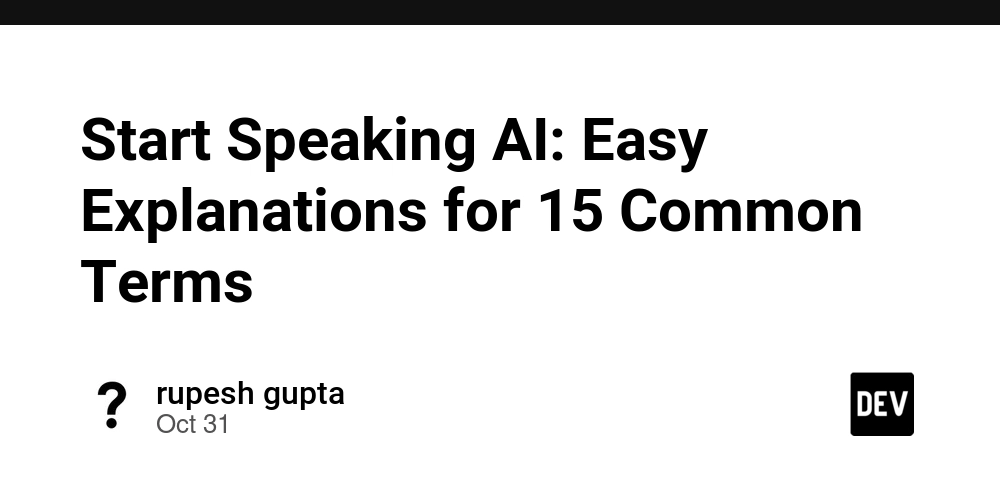Learn the language of AI in simple, everyday English — no tech degree required.
AI used to sound like science fiction.
Now it’s everywhere — in your phone, your work tools, even your fridge.
But with it comes a wave of new words that can feel confusing.
Whether you use ChatGPT, wonder how AI works, or just want to join the conversation, these 15 simple terms will help you speak AI fluently — in plain, simple English.
Let’s dive in 👇
⚙️ 1. Context Window
What it means: Think of this like AI’s short-term memory — how much information it can “remember” and work with at one time.
Why it matters: A bigger memory lets AI handle longer conversations without forgetting earlier details.
Example: Some models can remember about 6,000 words at once — good for one article, but not a whole book.
🧩 2. Chain-of-Thought (CoT)
What it means: It’s when AI shows its reasoning steps — like solving a math problem step by step.
Why it matters: Helps reduce mistakes and lets you follow the AI’s logic.
Example:
“20×17 = 340, 3×17 = 51, add them up = 391.”
🤖 3. LLM (Large Language Model)
What it means: The brain behind chatbots like ChatGPT. LLMs are trained on millions of texts to learn language patterns.
Why it matters: They’re the foundation of all generative AI tools today.
Example: ChatGPT, Claude, and Gemini are all LLMs.
🔍 4. RAG (Retrieval-Augmented Generation)
What it means: Combines AI’s memory with the ability to “look things up” before answering.
Why it matters: Keeps answers up-to-date and factual instead of relying only on old training data.
Example: A chatbot that checks your company docs in real time before replying.
🔡 5. Tokens
What it means: The small pieces of text AI breaks everything into — could be words, parts, or punctuation.
Why it matters: Token limits control how long your inputs or conversations can be.
Example: “AI is amazing!” = 4 tokens (AI + is + amazing + !).
🎯 6. Fine-Tuning
What it means: Teaching a general AI model to specialize in one area — like training a doctor to become a surgeon.
Why it matters: Makes AI much better at domain-specific tasks.
Example: Training ChatGPT on your company’s support chats to answer like your team.
🔥 7. Temperature
What it means: A setting that controls creativity.
- Low (0.2) = predictable and focused
-
High (0.9) = creative and random
Why it matters: Choose depending on your goal — accuracy or creativity.
Example:
Low: “Summarize this policy.”
High: “Write a fun ad inspired by this policy.”
✍️ 8. Prompt Engineering
What it means: The art of asking AI the right way to get the best results.
Why it matters: Great prompts lead to great outputs — poor ones waste time.
Example:
❌ “Explain AI.”
✅ “Explain AI in 3 simple sentences using an example a 10-year-old would understand.”
⚡ 9. Transformers
What it means: The technology that allows AI to understand relationships between words in a sentence.
Why it matters: This architecture powers all modern language models — including ChatGPT.
Example: The “T” in ChatGPT stands for Transformer.
📈 10. Embeddings
What it means: Numbers that represent meaning. Words with similar meanings have similar embeddings.
Why it matters: Helps AI understand semantic similarity — meaning over exact wording.
Example: “Cat” and “kitten” are close in vector space; “laptop” is far away.
🎥 11. Multimodal
What it means: AI that can process more than just text — like images, video, and sound.
Why it matters: Expands what AI can do, from analyzing photos to understanding voice.
Example: Upload a chart and ask, “What’s the trend here?” — the AI explains it visually.
🗃️ 12. Vector Database
What it means: Stores embeddings (those number versions of words) for fast similarity searches.
Why it matters: Lets AI find meaning-based matches instead of exact word matches.
Example: Searching “how to reset password” also finds “forgot my login.”
🤖 13. AI Agent
What it means: An AI that takes action, not just gives answers. It can plan, execute, and use tools.
Why it matters: Moves AI from being a helper to a doer.
Example: An AI that books your flights, compares hotels, and sends you an itinerary.
🛡️ 14. Guardrails / Safety Filters
What it means: Rules built into AI to prevent harmful, biased, or unsafe outputs.
Why it matters: Keeps AI trustworthy and socially responsible.
Example: Blocking private info or hate speech before it’s shown to users.
🚨 15. Hallucination
What it means: When AI confidently gives wrong or made-up information.
Why it matters: The biggest current limitation of AI — always verify critical facts.
Example: AI invents a fake “Harvard study” that doesn’t exist.
🚀 You Now Know the Language of AI!
Congratulations — you just learned 15 key concepts behind the world of Generative AI.
Now you can:
✅ Talk confidently about AI
✅ Understand what tools like ChatGPT are doing
✅ Avoid feeling lost in tech conversations
💬 Which term surprised you the most?
Or which one do you hear the most in your workplace?Let’s make the world a little more fluent in the language of AI — together! 🌍✨


